Corrosion of Silver-Plated Copper Conductors - NEPP
Corrosion of Silver-Plated Copper Conductors - NEPP
Corrosion of Silver-Plated Copper Conductors - NEPP
You also want an ePaper? Increase the reach of your titles
YUMPU automatically turns print PDFs into web optimized ePapers that Google loves.
334<br />
d. The plating type and thickness <strong>of</strong> the plating influences the corrosion<br />
susceptibility <strong>of</strong> the strands. <strong>Conductors</strong> finished with either pure nickel or pure<br />
tin exhibit no form <strong>of</strong> corrosion from the test environment. Strands finished with<br />
1μm <strong>of</strong> silver tend to corrode more rapidly than those with a nominal 2μm finish.<br />
Strands with defect-free silver finishes <strong>of</strong> 2μm did not corrode. Strands with<br />
Nickel Plus finishes showed only slight corrosion in isolated spots where defects<br />
existed in the nickel plating.<br />
e. There was no significant chemical difference between the average surface<br />
composition <strong>of</strong> strands supplied by different strand manufacturers once they had<br />
been processed into wires and cables. EDAX and Auger analyses identified<br />
relatively high concentrations <strong>of</strong> chlorine on the majority <strong>of</strong> the silver-plated<br />
conductors. Although products from different wire or cable processes gave a slight<br />
variation in the surface halide concentrations, this could not be correlated with the<br />
occurrence or extent <strong>of</strong> corrosion.<br />
f. The various manufacturing operations for processing individual silver-plated<br />
strands into finished wires or cables modifies the chemical structure <strong>of</strong> the strand<br />
surfaces. A marked increase was found in the copper and fluoride concentrations<br />
after processing.<br />
g. Metallography <strong>of</strong> the worst-case samples revealed that in any transverse plane less<br />
than 3%, <strong>of</strong> the strands had actually corroded.<br />
Visual inspection used to quantify the extent <strong>of</strong> corrosion is subjective, due to the<br />
widespread precipitation <strong>of</strong> corrosion products onto strands adjacent to the corrosion<br />
site. Metallographic inspection can be used as an additional evaluation, as it will<br />
provide more quantitative data.<br />
The onset <strong>of</strong> red-plague corrosion is totally dependent on the existence <strong>of</strong> exposed<br />
copper (resulting from defects in the silver-plated layer on copper strands), together<br />
with the presence <strong>of</strong> moisture.<br />
This report discusses how moisture can be introduced to the strand surfaces and a<br />
mechanism is proposed for the corrosion process. Complex, interrelated surface<br />
reactions involving the presence <strong>of</strong> ionisable halides and the effects <strong>of</strong> differential<br />
aeration may have a secondary role once the basic conditions for the corrosion<br />
mechanism exist.<br />
The investigation has not positively identified the direct reason for the corrosion<br />
discovered on the three reels described. lt is, however, concluded that the basic<br />
conditions for red-plague corrosion had existed, i.e. silver-plating imperfection and<br />
the presence <strong>of</strong> moisture.<br />
The mechanical or electrical integrity <strong>of</strong> wires and cables will not be severely<br />
degraded even in the event <strong>of</strong> corrosion existing to the extent seen on the worst case<br />
samples described in this paper.<br />
Recommendations The general requirements <strong>of</strong> SLP/2110 10 , which cover aspects <strong>of</strong> design, handling<br />
and processing, are adequate and necessary. It is emphasised that a greater effort must<br />
be made to follow those requirements.<br />
All stranding and braiding machines must be controlled by wire and cable<br />
manufacturers to ensure that they do not damage the continuity <strong>of</strong> the 2μm<br />
silver-plating. If this is an area <strong>of</strong> concern, it would be expedient to procure strands to<br />
a greater nominal silver thickness, (possibly 3 - 4μm).<br />
Humidity control for reels (spools) can be achieved by packaging in a sealed<br />
transparent plastic bag (polyvinyl chloride is prohibited). Desiccant or dry-nitrogen<br />
filling should be used in the packaging. An easy means for indicating that the<br />
humidity content is below 50%, RH should be provided, capable <strong>of</strong> being read without<br />
opening the package.<br />
The accelerated corrosion test 8 can be used as a screening method for silver-plated<br />
wires, particularly for very critical applications.<br />
ESA Journal 1984, Vol. 8






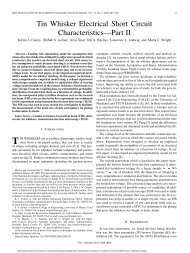
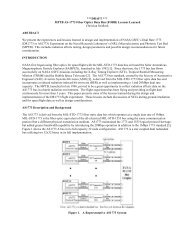

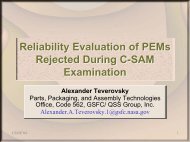
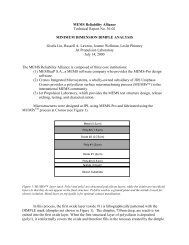
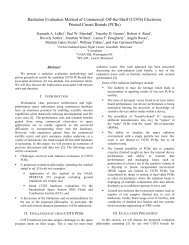
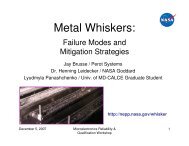



![mil-std-2223 [test methods for insulated electric wire] - NEPP](https://img.yumpu.com/4036001/1/190x249/mil-std-2223-test-methods-for-insulated-electric-wire-nepp.jpg?quality=85)